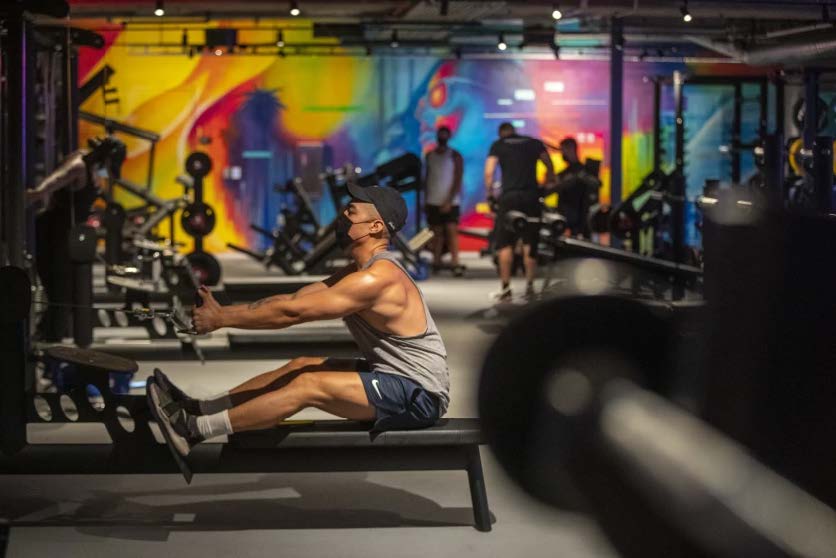
Gyms are mounting a comeback. But are people ready for communal sweating and panting?
Like many homebound gym fans, Hannah Ebeling was eager to hit the machines again, visiting her Planet Fitness in Tustin three or four times a week since it reopened in March.
“I would try to go on runs,” Ebeling said, “but I missed having that equipment to lift weights. I got bored just running around.”
Still, the college freshman and restaurant hostess has been put off by lines to enter at popular times — “I stopped going when it was most busy,” she said. And working out in a mask has its limits: “If I do the cardio machines, I have to stop because I can’t keep running with the mask on.”
Gym operators are keen to welcome back more members as COVID-19 safety precautions ease, but they and their customers face a changed world.
Friendship circles that made people want to go to a particular gym slipped away during long periods when fitness centers were locked down to prevent the spread of the coronavirus. Some gyms closed for good while others sold their businesses to other operators or slumped into bankruptcy.
With many customers up for grabs, gyms are scrambling to entice them, and landlords are betting that fitness centers and eventually other communal wellness businesses such as yoga and Pilates studios will be the comeback kids of the retail world laid low by the pandemic.
“Everything is being reset by COVID, when people put their memberships on freeze or terminated them,” real estate broker Scott Burns of JLL said. “When they come back, they are going to look at their options and see what else is out there.”
Many people eager to work out again will find the gym landscape altered by long periods of lockdown or enforced low occupancy. Some gyms were allowed to open for brief periods during the pandemic, only to be closed — and closed again — as new waves of COVID-19 struck.
“In 2020, the fitness industry had the most devastating year in its history,” consultant Rick Caro wrote in a recent edition of trade publication Club Industry.
Many gyms’ membership levels are less than half of what they were in March 2020, and large percentages of memberships are still on freeze and not paying monthly dues. Clubs’ revenue not from dues, which can include fees that personal trainers pay to gym owners, are often as low as 25% of pre-pandemic levels.
“Even with severe cost-cutting measures, clubs are struggling to break even,” Caro said in February. About 17% of all U.S. gyms closed permanently during the pandemic.
It could have been worse, but many gym owners chose the no-pain-no-gain route, said landlord Sandy Sigal, who controls 85 malls in three states and counts as many as 15 gyms among his tenants.
“They gritted it out, but many have done everything they had to — begged, borrowed and stole,” he said. “They’ve been holding on because everyone is hoping that when we reopen things will be really, really good for them and they’ll be able to make money.”
Most of the malls operated by Sigal’s Woodland Hills company NewMark Merrill Cos. are in California, but his malls in Illinois and Colorado are perhaps a bellwether for the Golden State when it comes to gym membership.
“Illinois and Colorado are big tells for us, because they’ve been open and more permissive longer than California has been,” he said. “Our Illinois and Chicago gyms are back to 100% of what they were prior” to the pandemic. “We are going right to capacity.”
None of the gyms in NewMark’s malls have gone out of business during the pandemic, but Sigal struck deals with some operators who had trouble paying their rent. He agreed to let them pay half, he said, and defer paying the other half until times improved. They have as long as two years to repay the rent, without interest.
The pandemic has been devastating to many mall businesses that had to close temporarily or limit access to customers, but shopping center owners have an extra incentive to keep gyms afloat — they may attract patrons to the stores and restaurants around them.
About 20% of the people who come to the gym on a given day patronize another business in the mall before or after their workouts, according to research by NewMark, Sigal said. When operating at full capacity, gyms may get 600 to 1,000 visitors a day.
Fitness centers weren’t always considered desirable rainmakers by landlords.
Gyms earned mass appeal in the late 20th century as Americans took greater interest in their physical health. But if they were allowed into malls at all, they were commonly relegated to spaces other merchants considered undesirable, such as basements or the backside.
“Gyms used to face the back parking lot and not interact with other retail stores,” Sigal said. “They were perfect for taking space that wasn’t really retail space.”
Other tenants tended to consider gyms déclassé and parking place hogs, he said, but their reputation as neighbors has improved in the last decade as many fitness centers have turned toward luxury and many traditional department stores have closed their doors.
Landlords have elevated gyms to anchor status to fill big empty spaces, he said, and other merchants have concluded that gyms may be good for business. High-end fitness centers such as Equinox are able to command prominent locations.
Barry’s Bootcamp recently agreed to move its West Hollywood gym to a building owned by the city that was once occupied by a picture frame shop.
The pandemic is clearly waning in California, with public health experts growing increasingly confident that the worst of COVID-19 is behind the state, and the economy is expected to be largely reopened by June 15.
This month, Los Angeles County entered the most lenient level of COVID-19 restrictions, the yellow tier, which doubled allowed gym occupancy to 50% of capacity from 25% and permits the use of locker rooms, showers, pools, saunas and steam rooms.
The U.S. Centers for Disease Control and Prevention on Thursday announced a sweeping relaxation of face mask guidelines to allow fully vaccinated people to safely stop wearing masks in most places, including inside gyms. California and Los Angeles County, however, haven’t yet adopted the CDC’s latest recommendations.
Los Angeles gym manager Robert Hull has an online booking system at John Reed Fitness, a new club in downtown Los Angeles that has been in the works since before the pandemic and opened in March.
Hull declined to reveal membership numbers but said there has been a jump in interest since the county eased restrictions on gyms May 6. Shedding weight picked up during hibernation is a common theme among members.
“People want to lose what they gained during quarantine,” Hull said, “and have access to equipment.”
The communal aspect of a gym also holds appeal, he said.
“People are excited to have the camaraderie to be motivated again,” he said. Seeing fellow members striving “helps other individuals to get motivated” to push themselves, he said.
The John Reed chain was founded in Berlin in 2016, and downtown’s outpost is the first in the U.S. Its signature is a colorfully lighted environment in which a live DJ pumps the music and walls are filled with work by local artists such as L.A. street muralist Robert Vargas.
Like other gyms, John Reed takes pains to demonstrate cleanliness to wary members, such as wiping down equipment and disinfecting lockers after every use. Temperature checks, social distancing and masks are enforced, and those who don’t follow the rules are ejected, Hull said.
A recent case in Canada illustrates why caution in gyms has been necessary to protect public health. Mega Fitness Gym 24H in Quebec City was shuttered by health officials March 31 after being linked to one of Canada’s most far-reaching coronavirus outbreaks.
At least 224 people were infected at the gym, CBC News reported. The exact source of the outbreak was not identified, but health authorities said the gym was in violation of at least three public health orders before it was shut down.
Outdoor workouts at a gym are now the preferred fitness program for Imari Williams, in part because they feel safer. His fitness club, Amp Association in Santa Monica, has set up workout stations in space once used for parking.
“Outside, you get fresh air and there is no ceiling,” said Williams, a voice-over actor who lives in Santa Monica. “It’s really kind of freeing.”
Williams, whose credits include commercials for Planet Fitness, said that months ago he planned to come out of the pandemic “looking like a beast” but that his home workouts and jogging didn’t cut it. “I fell off and gained a bunch of weight.”
Fitness center operators and investors are betting that, like Williams, most people who like to work out prefer to do it at a gym, property broker Burns said.
Smaller fitness-oriented businesses such as yoga, spin classes and personal training facilities have yet to recover at the same pace as gyms, Burns said, but he expects them to return as a category.
The fitness industry was expanding and “doing a ton of deals” tying up space before the pandemic, he said, and operators of full-size gyms are again prowling for locations in Southern California. Some of the spaces available were shed by 24 Hour Fitness during a Chapter 11 reorganization last year that saw the permanent closure of more than 100 clubs in multiple states.
“The long-range perspective most of these larger fitness users have is that this is just a blip, we’re going to get through it, and people are going to get back into our gyms,” Burns said.
From LAtimes.com. Click here for the full article
